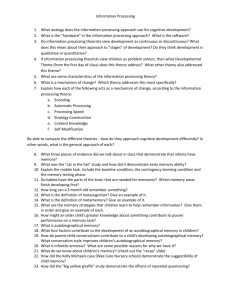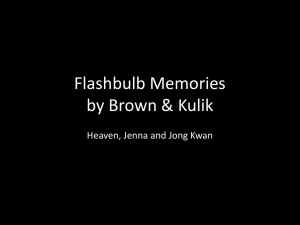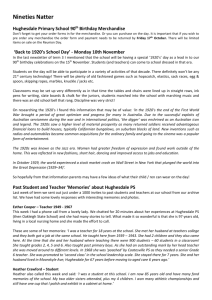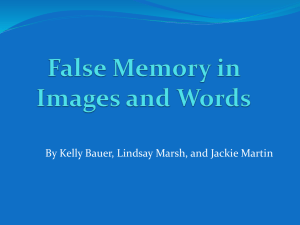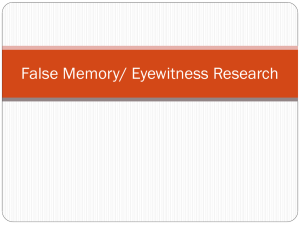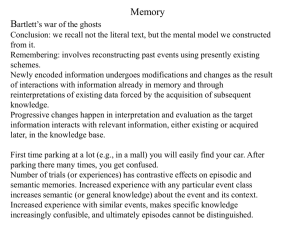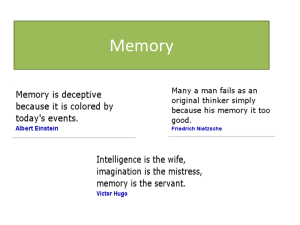Unit Plan - Curriculum Team News
advertisement
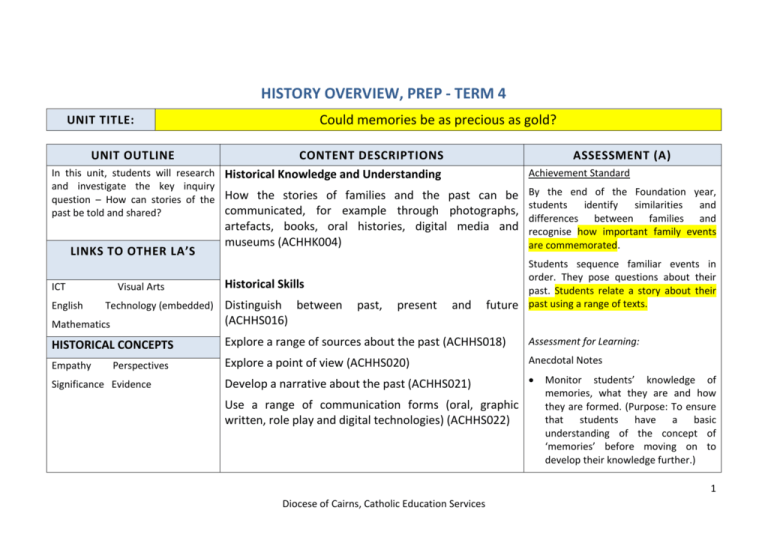
HISTORY OVERVIEW, PREP - TERM 4 Could memories be as precious as gold? UNIT TITLE: UNIT OUTLINE CONTENT DESCRIPTIONS In this unit, students will research Historical Knowledge and Understanding ASSESSMENT (A) Achievement Standard and investigate the key inquiry By the end of the Foundation year, question – How can stories of the How the stories of families and the past can be students identify similarities and communicated, for example through photographs, past be told and shared? differences between families and artefacts, books, oral histories, digital media and recognise how important family events museums (ACHHK004) are commemorated. LINKS TO OTHER LA’S ICT Visual Arts Historical Skills Mathematics Distinguish between (ACHHS016) HISTORICAL CONCEPTS Explore a range of sources about the past (ACHHS018) Assessment for Learning: Empathy Explore a point of view (ACHHS020) Anecdotal Notes Develop a narrative about the past (ACHHS021) English Technology (embedded) Perspectives Significance Evidence past, present and Students sequence familiar events in order. They pose questions about their past. Students relate a story about their future past using a range of texts. Use a range of communication forms (oral, graphic written, role play and digital technologies) (ACHHS022) Monitor students’ knowledge of memories, what they are and how they are formed. (Purpose: To ensure that students have a basic understanding of the concept of ‘memories’ before moving on to develop their knowledge further.) 1 Diocese of Cairns, Catholic Education Services Assessment as Learning: Students report orally to other students – Checklist of Speaking and listening skills. (Purpose: To gauge student’s ability to articulate their point of view evidenced by a source or sources from the past.) Checklist/Anecdotal notes to record that each child has articulated a memory with relevant information included. (Purpose: To gauge student’s knowledge at this stage, of a personal memory triggered by an artifact. Give feedback to students as required.) Anecdotal notes to record student’s ability to identify his/her memories as Gold, Silver or Bronze memories. (Purpose: To gauge the student’s understanding the concept of the value of memories and to feedback to those having difficulty.) Assessment of Learning: Assessment Task: Students produce a ‘memory artwork’ and an oral explanation of how a memory can be made of gold to different people. The oral 2 Diocese of Cairns, Catholic Education Services presentation should be recorded digitally. The artwork and digital narrative of the past are in response to the big question and will be displayed in the ‘Memories are as Precious as Gold’ Gallery/Museum. See Assessment Task and Criteria Sheet DEVELOPING INQUIRING AND REFLECTIVE LEARNERS Community Leader Contributor and Collaborator Effective Communicator Designer and Active Investigator Quality Creator Producer 3 Diocese of Cairns, Catholic Education Services CROSS CURRICULA PRIORITIES Catholic Ethos The overarching purpose of Catholic schools of the past, as well as the future, is to bring the Good News of Jesus to all who hear it. In the midst of a world of educational, social and economic change the focus on the holistic growth of the individual remains the surest way catholic school can prepare students for the uncertainties of the future. Aboriginal and Torres Strait Islander Histories and Cultures Asia and Australia’s Engagement with Asia Active engagement of inclusive curriculum practices which reflect Aboriginal and Torres Strait Islander perspectives, knowledge, histories, cultures and spirituality. A genuine commitment to Reconciliation, guided by principles of personal dignity, social justice and equity, which reflects the Gospel message and the mission of the Church. This perspective requires students to develop skills, knowledge and understandings related to Asia and Australia’s engagement with Asia. Social Emotional Learning Inclusive Education The curriculum provides opportunities to know, understand and be able to: 1. Understand ‘Asia’ 2. Develop informed attitudes and values Defining Features, Diocese of Cairns The curriculum provides opportunities to value and 3. Know about contemporary and traditional The curriculum provides opportunities for young respect: Asia people to connect their curriculum experiences to a 1. traditional knowledge and practices 4. Connect Australia and Asia living Christian faith. 2. culture and natural heritage 5. Communicate effectively with people of the 3. spirituality Asian region both within and outside and to critically examine and/or challenge: Australia confidently 1. social constructs 2. prejudice and racism Sustainability Education Access to current information about environmental Social and emotional competencies are integral to It is by the quality of interactions and relationships issues and promotion of a reflective and responsive academic and work success and are the basis of that all students learn to understand and appreciate attitude towards stewardship of the gifts of creation. resilience, relational quality and social capital. difference, to value diversity and learn to respond with dignity and respect to all through mutually The curriculum provides opportunities to reflect The curriculum provides opportunities to develop: enriching interactions. upon: 1. Self Awareness 1. the gift of creation 2. Social Awareness The curriculum provides equitable access for and/or 2. an attitude of responsible stewardship 3. Responsible Decision Making positive interactions with students from different and to critically examine and/or challenge: 4. Self-Management backgrounds and with diverse needs and abilities. 1. the impact of human interaction with the 5. Relationship Management natural, built and social environment 2. current environmental issues 4 Diocese of Cairns, Catholic Education Services GENERAL CAPABILITIES Literacy Students become literate as they develop the skills to learn and communicate confidently at school and to become effective individuals, community members, workers and citizens. These skills include listening, reading, viewing, writing, speaking and creating print, visual and digital materials accurately and purposefully within and across all learning areas. Students become numerate as they develop the capacity to recognise and understand the role of mathematics in the world around them and the confidence, willingness and ability to apply mathematics to their lives in ways that are constructive and meaningful. Literacy involves students engaging with the language and literacy demands of each learning area. As they become literate students learn to: interpret, analyse, evaluate, respond to and construct increasingly complex texts (Comprehension and composition) understand, use, write and produce different types of text (Texts) manage and produce grammatical patterns and structures in texts (Grammar) make appropriate word selections and decode and comprehend new (basic, specialised and technical) vocabulary (Vocabulary) use and produce a range of visual materials to learn and demonstrate learning (Visual information) As they become numerate, students develop and use mathematical skills related to: Calculation and number Patterns and relationships Proportional reasoning Spatial reasoning Statistical literacy Measurement. Critical and Creative Thinking Information and Communication Technology Numeracy Students develop ICT competence when they learn to: Investigate with ICT: using ICT to plan and refine information searches; to locate and access different types of data and information and to verify the integrity of data when investigating questions, topics or problems Create with ICT: using ICT to generate ideas, plans, processes and products to create solutions to challenges or learning area tasks Communicate with ICT: using ICT to communicate ideas and information with others adhering to social protocols appropriate to the communicative context (purpose, audience and technology) Operate ICT: applying technical knowledge and skills to use ICT efficiently and to manage data and information when and as needed Apply appropriate social and ethical protocols and practices to operate and manage ICT. Students develop critical and creative thinking as they learn to generate and evaluate knowledge, ideas and possibilities, and use them when seeking new pathways or solutions. In learning to think broadly and deeply students learn to use reason and imagination to direct their thinking for different purposes. In the context of schooling, critical and creative thinking are integral to activities that require reason, logic, imagination and innovation. As they develop critical and creative thinking students learn to: pose insightful and purposeful questions apply logic and strategies to uncover meaning and make reasoned judgments think beyond the immediate situation to consider the ‘big picture’ before focussing on the detail suspend judgment about a situation to consider alternative pathways reflect on thinking, actions and processes generate and develop ideas and possibilities analyse information logically and make reasoned judgments evaluate ideas and create solutions and draw conclusions assess the feasibility, possible risks and benefits in the implementation of their ideas transfer their knowledge to new situations 5 Diocese of Cairns, Catholic Education Services Ethical Behaviour Students develop ethical behaviour as they learn to understand and act in accordance with ethical principles. This includes understanding the role of ethical principles, values and virtues in human life; acting with moral integrity; acting with regard for others; and having a desire and capacity to work for the common good. As they develop ethical behaviour students learn to: recognise that everyday life involves consideration of competing values, rights, interests and social norms identify and investigate moral dimensions in issues develop an increasingly complex understanding of ethical concepts, the status of moral knowledge and accepted values and ethical principles explore questions such as: o What is the meaning of right and wrong and can I be sure that I am right? o Why should I act morally? o Is it ever morally justifiable to lie? o What role should intuition, reason, emotion, duty or self-interest have in ethical decision making? Personal and Social Competence Students develop personal and social competence as they learn to understand and manage themselves, their relationships, lives, work and learning more effectively. This involves recognising and regulating their emotions, developing concern for and understanding of others, establishing positive relationships, making responsible decisions, working effectively in teams and handling challenging situations constructively. As they develop personal and social competence students learn to: recognise and understand their own emotions, values and strengths, have a realistic assessment of their own abilities and a well-grounded sense of self-esteem and selfconfidence (Self-awareness) manage their emotions and behaviour, persevere in overcoming obstacles, set personal and academic goals, develop self-discipline , resilience, adaptability and initiative (Self-management) perceive and understand other people’s emotions and viewpoints, show understanding and empathy for others, identify the strengths of team members, define and accept individual and group roles and responsibilities, be of service to others (Social awareness) form positive relationships, manage and influence the emotions and moods of others, cooperate and communicate effectively with others, work in teams, build leadership skills, make decisions, resolve conflict and resist inappropriate social pressure (Social management). Intercultural Understanding Students develop intercultural understanding as they learn to understand themselves in relation to others. This involves students valuing their own cultures and beliefs and those of others, and engaging with people of diverse cultures in ways that recognise commonalities and differences, create connections and cultivate respect between people. As they develop intercultural understanding students learn to: identify increasingly sophisticated characteristics of their own cultures and the cultures of others recognise that their own and others’ behaviours, attitudes and values are influenced by their languages and cultures consider what it might be like to ‘walk in another’s shoes’ compare the experiences of others with their own, looking for commonalities and differences between their lives and seeking to understand these reflect on how intercultural encounters have affected their thoughts, feelings and actions accept that there are different ways of seeing the world and live with that diversity stand between cultures to facilitate understanding take responsibility for developing and improving relationships between people from different cultures in Australia and in the wider world contribute to and benefit from reconciliation between Indigenous and non-Indigenous Australians. 6 Diocese of Cairns, Catholic Education Services WEEKLY PLANNER WEEK 1 2 3 4 5 GENERAL CAPABILITIES 6 7 8 9 10 CROSS CURRICULAR PRIORITIES CE SEL IE Tuning In Exploring Looking Sorting Acting TUNING IN Lesson One Building interest Display an item related to the story ‘Wilfred Gordon McDonald Partridge’ by Mem Fox to spark children’s interest in upcoming unit. E.g. A basket filled with ‘memories’, an egg, a rubber thong like the one Wilfred wears in the story, a picture of Wilfred. Discuss: What are these things? Why are they here? What do all these things mean? Read ‘Wilfred Gordon McDonald Partridge’ by Mem Fox to the children. - Also on YouTube http://www.youtube.com/watch?v=usnOEnTXabw Discuss Wilfred’s name. Why so many names? Is he named after other people? Why are the names so old? Etc Reflecting RESOURCES Teacher Resources: Story – Wilfred Gordon McDonald Partridge by Mem Fox YouTube – Wilfred Gordon McDonald Partridge story by Mem Fox http://www.youtube.com/watch?v=usnOEn TXabw ASSESSMENT / MONITORING OPPORTUNITIES Anecdotal notes Monitor student’s knowledge of memories, what they are and how they are formed. Further discussion What is a memory? Why do we have memories? How are they made? Where are memories stored? When do the actions of memories occur? Past? Present? Future? Talk about memories from long ago and memories from yesterday. Grandparents have much longer memories then children, why is that? I wonder if we ever stop making memories? Distinguish between past, present and future? Which time do our memories relate to? 7 Diocese of Cairns, Catholic Education Services HISTORICAL LANGUAGE Memories, Yesterday, Today, past, present, future REFLECTION 8 Diocese of Cairns, Catholic Education Services WEEK 1 2 3 4 GENERAL CAPABILITIES 5 6 7 8 Exploring Looking 10 CROSS CURRICULAR PRIORITIES CE Tuning In 9 Sorting Testing SEL Acting IE Reflecting EXPLORING RESOURCES Wilfred Gordon collected artefacts which triggered memories of the old people in the home next door. He placed them in a basket and carried them with him collecting more and more with each person he spoke with. Student Resources: Memory artefacts Shoe box Art / Collage Materials to decorate the boxes Lesson Two Teacher brings in a shoebox of artefacts and relays memories related to each item inside. E.g. – dancing medal, toy from childhood, Baptism bangle, Grandmothers handkerchief, etc. Students share some of their own memories. Discuss some of their own artefacts they could bring in as a visual reminder of their memory – soccer trophy, Grandfathers old cap, riding saddle, etc. This could be an opportunity for making links to Indigenous, Asian or other cultural heritages. Discuss the length of memories – Wilfred found the shoe box of precious shells he found a long time ago – last summer. What is a long time ago to you? What is a long time ago to your Grandmother? Discuss perspectives of different people and different lengths of time, the older you are the longer your memories will be. Look at a time line comparing life time of a child vs. an adult, e.g. 5 years and 40 years on a number line. 40 year old has had much longer to make memories than the 5 year old. Revise the concepts of past, present and future. When have these memories occurred? Lesson Three Activity – Think, Pair, Share Prior to this lesson children think about memories that are important to them and collect artefacts from Teacher Resources: Think pair share Memory artefacts Number line Camera Checklist for assessment ASSESSMENT / MONITORING OPPORTUNITIES Anecdotal notes/Checklist: Speaking and listening skills – Students articulate their point of view with an artefact/s as a source from the past. The students are able to distinguish between the past, present and future. 9 Diocese of Cairns, Catholic Education Services home to bring in and show. Encourage children to bring 4-5 artefacts in a box. Children pair with another child and share their memories and show all their artefacts. Children move into groups of 6 and share 1 memory from their box with the group. As a whole class, students report back a memory of the person sitting beside them in the small group activity. Checklist/Anecdotal notes to record that each child has articulated a memory with relevant information included. * If possible children can keep their shoe box or memory box at school to decorate in an art lesson and display in the classroom. Lesson Four Invite family members into the class to share their precious memories and bring in artefacts to show the children. Again this could be an opportunity to bring in family members from various cultural backgrounds. Create a roster for parents – 2-4 each day to share a memory with the children. This might occur over the next 3 weeks and should only take 5 minutes each parent / Grandparent. NB Encourage parents / Grandparents to include memories of war experiences, family celebrations and Indigenous, Asian or other cultural perspectives. Take photos of family members sharing their memories and create either a ‘Remember when…” book with the photos taken, or a digital presentation. HISTORICAL LANGUAGE Memories, artefacts, experiences, photographs, oral histories, perspectives, point of view REFLECTION 10 Diocese of Cairns, Catholic Education Services WEEK 1 2 3 4 GENERAL CAPABILITIES 5 6 7 8 Exploring Looking 10 CROSS CURRICULAR PRIORITIES CE Tuning In 9 Sorting Testing SEL Acting SORTING IE Reflecting RESOURCES Introduction to the Lesson: Wilfred Gordon discovered that memories could be described as ‘As precious as gold’. Introduce the notion of comparison through the use of simile… ‘as precious as gold’. (Current price of old is around $50 per gram. Show children a 250g block of butter – explain that if it was made of GOLD, it would be worth $12, 500. This is a lot of money! Try to give children some concept how much money or the value that this has. You may also like to explore another comparison simile such as: ‘as fast as the wind!” What does this mean? Why would we describe something like this? Could we describe memories we have collected be as precious as gold? What makes a memory precious? Student Resources: Artefacts Coloured pencils Scissors Lesson Five Sort through the memories that make us feel good and help us remember who we are. Discuss how not all memories are happy memories but they can be important memories – remembering the anniversary of a death of someone in the family. E.g. Remembering Grandma has died is sad, but we remember the wonderful things she used to do or what she has taught us. Memories document your life and only you have those memories, no one else has the same memories as you. Balance scales – one for each group of 6 children Teacher Resources: Coloured stones or other weighted materials (available at Overflow) Tally chart for whole class representation of gold, silver, bronze medals (See appendices for a template to enlarge.) White paper memory disc template (see appendices) 11 Diocese of Cairns, Catholic Education Services ASSESSMENT / MONITORING OPPORTUNITIES Monitoring through anecdotal notes or checklists: Student’s participation in discussions. (Provide feedback to students.) - (Coloured Stones) Teacher models the importance of memories by using a balance scale and coloured stones. The artefact is the object that triggers the memory and the stones represent how much the memory is worth to us. - The more precious the memory, the more stones you will place in the side of the scale to represent how much it means to you. (We are looking to compare the amount of stones that denote the importance of the memory for us.) Compare the amount of stones for each memory and link it to Gold, Silver and Bronze memories. i.e – the largest pile of stones is a gold memory, the smallest pile is the bronze memory. Discuss how gold is a precious metal and is worth a lot of money. Could memories be as precious as gold? (You could make the simile as precious as silver, as precious as bronze.) Follow up home task: Recall 1 of your own memories from the memory box and collect 2 more memories with artefacts to represent them from family members e.g. a parent and a Grandparent. Students can bring more than one artefact to remind them of their memory. Discuss at home the importance of these memories to the person to whom they belong. Student’s ability to identify his/her memories as gold, silver or bronze memories. (Note students having difficulty articulating their point of view.) Monitor the students’ ability to articulate other points of view when they feed back the information gathered from their Grandparents or parents in regard to the gold, silver or bronze memories. Lesson Six In groups of 6, sort memories represented by artefacts into Gold, Silver or Bronze using the balance scale and coloured pebbles / other weighted materials. Each child measures and decides whether their memories are bronze, silver or gold. They then colour in a white paper memory disc (see template) yellow for gold, grey for silver or brown for bronze to represent what each memory is made of and draw a small picture of the artefact used to represent the memory e.g. a bangle, coin, photo. 12 Diocese of Cairns, Catholic Education Services As a whole class, the children collate information by gluing discs onto tally sheets to show how many gold, silver and bronze memories were collected. (See appendix for template that can be enlarged.) Follow up home task: Send the memories home and have parents and grandparents sort the memories too. To different people memories will have varying degrees of importance. What is the gold memory for all your family members? (e.g. I saw the birthday party as my gold memory because I got a wonderful toy I wanted for such a long time. Mum saw it as a gold memory because it was my first birthday party with friends from school. Nana saw it as a gold memory because I’m her oldest grandson) Discuss/share in class what the children find out from home. Gold Memories Silver Memories Bronze Memories HISTORICAL LANGUAGE Memories, artefact, oral histories, photographs, books, story, point of view 13 Diocese of Cairns, Catholic Education Services REFLECTION WEEK 1 2 3 4 GENERAL CAPABILITIES 5 6 7 8 Exploring Looking 10 CROSS CURRICULAR PRIORITIES CE Tuning In 9 Sorting Testing SEL Acting ACTING Test the information we have gathered and sorted against the big question – Could memories be as precious as gold? Lesson Seven Review sorting process and teacher models answer to the big question. Show students your artefact/s that helped you remember your memory. ‘My gold memory was when I got my first soccer medal when I six years because it was very exciting and I worked hard to get it. I got this medal 20 years ago. It was also a gold memory for my Mum as she was very proud of me. Mum remembers the big smile I had on my face. My Nan said it was a gold memory to her because she knew I had worked hard and persisted to win it and she was proud of my effort. She has a photo of me with my first medal. This one memory was as precious as gold to all of us.’ Video students showing their artefact and sharing why their memory is as precious as gold to all the members of their family. This can be done in small groups using Photo booth, during an ICT lesson, using a IE Reflecting RESOURCES Student Resources: Artefact Materials to create artwork – paper, water colours, paint, glue, collage materials, charcoal etc Teacher Resources: Video camera / Photobooth (Mac computer)/ ipad Audacity program – free download for Mac or Windows (http://audacity.sourceforge.net/) 14 Diocese of Cairns, Catholic Education Services video camera (this option may take longer) or an ipad, or the Audacity program (for recording and edit sounds). Some could be recorded and linked to QR codes to go beside the artwork. Collect Art materials Display materials Lesson Eight and Nine Creating a gallery/museum of memories – ‘Memories are as precious as Gold’ Gallery can be created in any way the teacher wishes – Art works + Oral explanation using Audacity program, a video camera or an ipad etc Create a picture of your golden memory using watercolours on tissue paper, on canvas, collage, – some medium other than normal pencils or paint. Create an art gallery in your classroom and display artwork and reasons why each visual art piece is a gold memory. Set up an area where videos / Photo booth recordings/ recorded message can be displayed and heard while students view their artwork. (Some could be linked to QR codes displayed beside the artwork.) Speakers for computer QR code maker and reader http://www.interactivestudios.net/barcode/createcode.aspx ASSESSMENT / MONITORING OPPORTUNITIES Assessment Task: Students produce a ‘memory artwork’ and an oral explanation of how a memory can be made of gold to different people. The oral presentation should be recorded digitally See Assessment Task and Criteria Sheet 15 Diocese of Cairns, Catholic Education Services HISTORICAL LANGUAGE Artefacts, memories, oral histories, story, past, sources. REFLECTION 16 Diocese of Cairns, Catholic Education Services WEEK 1 2 3 4 GENERAL CAPABILITIES 5 6 7 8 Exploring Looking 10 CROSS CURRICULAR PRIORITIES CE Tuning In 9 Sorting Testing SEL Acting REFLECTING IE Reflecting RESOURCES Lesson Ten Resources: Hold an exhibition ‘Memories Are As Precious As Gold Museum/Gallery’ and invite parents, grandparents, Art work and digital recordings family etc. to come and view it. ASSESSMENT / MONITORING OPPORTUNITIES Completed work from the unit to be displayed and shared with family, school and/or the wider community. Work may be shared with the wider community through school newsletter, older years, assembly, etc. 17 Diocese of Cairns, Catholic Education Services HISTORICAL LANGUAGE Memories, museum,past REFLECTION 18 Diocese of Cairns, Catholic Education Services Educational Modifications CLASSROOM ACCOMMODATIONS FOR WHOM Seat near teacher Assign student to low- distraction area Seat near positive peer models Use support groups / cooperative learning Use rows instead of tables Use learning centre Use of time-out Stand near student when giving instruction Arrange classroom for safe visibility, accessibility and movement PRESENTATION OF LESSONS FOR WHOM Adjust work load, reduce assignments or give alternative assignments Use visual aids with oral presentation Teacher gives student outlines or study guides Ensure regular lesson revisits/reviews Highlight instructions (marker or highlighter tape) Give clear behavioural objectives Ask student to repeat instructions for clarification and understanding Use high- impact game-like materials Call on student often Acknowledgment effort put forth Give reminders for student to stay on task, monitor student is on task/topic Use large type/font and dark ink Keep page format simple Use visual prompts Divide page into clearly marked sections Remove distractions from paper ALTERNATIVE EVALUATION PROCEDURES FOR WHOM Reduce number of items Practice completely similar questions Arrange for oral testing Have support staff administer test Permit student to type or use word processing Adjust grading criteria based on individual Adjusted grading option Diocese of Cairns, Catholic Education Services NOTE TAKING STRATEGIES FOR WHOM Provide student the means to record Arrange for note taker e.g. Aide Give student a copy of notes Provide time for periodic review of student’s notes (written, dictated, word processed) ORGANISATIONAL STRATEGIES FOR WHOM Use calendar to plan assignments Use of assignment notebook or work checklist especially diary Daily schedule Give time top organise desk during class AM check-in to organise for the day Lunch-time check-in to organise for PM PM check-out to organise for homework Arrange a duplicate set of classroom material for use at home Develop parent/school contract Training in time management SUPPORT SERVICES FOR WHOM Peer tutoring Cross-age tutoring Student buddy Work with school officer Meet with staff during available times Teach student to monitor own behaviour Implement behaviour contract/reward Self advocacy/communication skill training Conflict resolution strategies Other _____________________ Adapted with permission from Positive Partnerships PD Facilitators Guide Module 5 Support materials Diocese of Cairns, Catholic Education Services
